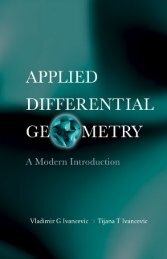PMeulogt MacLane
PMeulogt MacLane
PMeulogt MacLane
You also want an ePaper? Increase the reach of your titles
YUMPU automatically turns print PDFs into web optimized ePapers that Google loves.
SAUNDERS MAC LANE 239<br />
underlies the particular theories and unifies them with respect<br />
to those central features. (Moore [1908], p. 98)<br />
Category theory was created to find the unity behind deep analogies<br />
between topology and algebra. Today it is a standard format for giving<br />
such ‘general abstract’ theories. The relation of Moore to Mac Lane would<br />
repay far more attention than it has gotten. 4<br />
Studying logic in Göttingen from 1931 to 1933, right after Gödel’s<br />
incompleteness theorem, Mac Lane developed a strong feeling for Hilbert’s<br />
‘formalism’. He had an exchange in the New York Review of Books with<br />
Freeman Dyson on the point. Dyson claimed Hilbert had gone ‘into a blind<br />
alley of reductionism ... reducing mathematics to a set of marks written<br />
on paper, and deliberately ignoring the context of ideas and applications<br />
that give meaning to the marks’. Mac Lane said to the contrary that Hilbert<br />
meant quite concrete mathematical knowledge in his famous slogan Wir<br />
müssen wissen; wir werden wissen (We must know, we will know): ‘This<br />
was the tone of his general lecture course on the philosophy of science<br />
which I heard him give in late 1931.’ Hilbert used formalization in its own<br />
proper domain:<br />
Hilbert himself called this ‘metamathematics’. He used this<br />
for a specific limited purpose, to show mathematics consistent.<br />
Without this reduction, no Gödel’s theorem, no definition<br />
of computability, no Turing machine, and hence no<br />
computers.<br />
Dyson simply does not understand reductionism and the deep<br />
purposes it can serve. Hilbert was not ‘sterile’.<br />
Dyson finally agreed with him about Hilbert and said ‘Hilbert himself was,<br />
of course, a master of both [formal and concrete] kinds of mathematics’,<br />
but oddly Dyson would not extend the same concession to Mac Lane. He<br />
insisted Mac Lane ‘is by temperament a reductionist’. In fact Mac Lane<br />
was no kind of reductionist. He saw what formalization could achieve<br />
while he was constantly involved with the ideas and applications that<br />
give it meaning. 5<br />
The specific project of his Göttingen dissertation was to give<br />
formal means of abbreviating formal proofs. But the larger goal was<br />
to bring formal logic closer to practice and make it express more<br />
directly how<br />
A proof is not just a series of individual steps, but a group<br />
of steps, brought together according to a definite plan or<br />
4 Thanks to William Lawvere for emphasizing this. On Moore see Parshall and Rowe<br />
[1994].<br />
5 This paragraph quotes Mac Lane [1995b].














